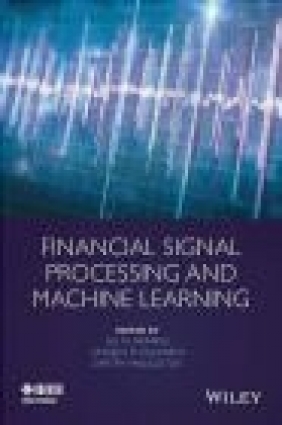Financial Signal Processing and Machine Learning
Financial Signal Processing and Machine Learning
- Wydawnictwo: John Wiley
- Rok wydania: 2016
- ISBN: 9781118745670
- Ilość stron: 320
- Oprawa: Twarda
Niedostępna
Opis: Financial Signal Processing and Machine Learning
The modern financial industry has been required to deal with large and diverse portfolios in a variety of asset classes often with limited market data available. Financial Signal Processing and Machine Learning unifies a number of recent advances made in signal processing and machine learning for the design and management of investment portfolios and financial engineering. This book bridges the gap between these disciplines, offering the latest information on key topics including characterizing statistical dependence and correlation in high dimensions, constructing effective and robust risk measures, and their use in portfolio optimization and rebalancing. The book focuses on signal processing approaches to model return, momentum, and mean reversion, addressing theoretical and implementation aspects. It highlights the connections between portfolio theory, sparse learning and compressed sensing, sparse eigen-portfolios, robust optimization, non-Gaussian data-driven risk measures, graphical models, causal analysis through temporal-causal modeling, and large-scale copula-based approaches. Key features: * Highlights signal processing and machine learning as key approaches to quantitative finance. * Offers advanced mathematical tools for high-dimensional portfolio construction, monitoring, and post-trade analysis problems. * Presents portfolio theory, sparse learning and compressed sensing, sparsity methods for investment portfolios. including eigen-portfolios, model return, momentum, mean reversion and non-Gaussian data-driven risk measures with real-world applications of these techniques. * Includes contributions from leading researchers and practitioners in both the signal and information processing communities, and the quantitative finance community.List of Contributors xiii Preface xv 1 Overview 1 Ali N. Akansu, Sanjeev R. Kulkarni, and Dmitry Malioutov 1.1 Introduction 1 1.2 A Bird's-Eye View of Finance 2 1.2.1 Trading and Exchanges 4 1.2.2 Technical Themes in the Book 5 1.3 Overview of the Chapters 6 1.3.1 Chapter 2: "Sparse Markowitz Portfolios" by Christine De Mol 6 1.3.2 Chapter 3: "Mean-Reverting Portfolios: Tradeoffs between Sparsity and Volatility" by Marco Cuturi and Alexandre d'Aspremont 7 1.3.3 Chapter 4: "Temporal Causal Modeling" by Prabhanjan Kambadur, Aurelie C. Lozano, and Ronny Luss 7 1.3.4 Chapter 5: "Explicit Kernel and Sparsity of Eigen Subspace for the AR(1) Process" by Mustafa U. Torun, Onur Yilmaz and Ali N. Akansu 7 1.3.5 Chapter 6: "Approaches to High-Dimensional Covariance and Precision Matrix Estimation" by Jianqing Fan, Yuan Liao, and Han Liu 7 1.3.6 Chapter 7: "Stochastic Volatility: Modeling and Asymptotic Approaches to Option Pricing and Portfolio Selection" by Matthew Lorig and Ronnie Sircar 7 1.3.7 Chapter 8: "Statistical Measures of Dependence for Financial Data" by David S. Matteson, Nicholas A. James, and William B. Nicholson 8 1.3.8 Chapter 9: "Correlated Poisson Processes and Their Applications in Financial Modeling" by Alexander Kreinin 8 1.3.9 Chapter 10: "CVaR Minimizations in Support Vector Machines" by Junya Gotoh and Akiko Takeda 8 1.3.10 Chapter 11: "Regression Models in Risk Management" by Stan Uryasev 8 1.4 Other Topics in Financial Signal Processing and Machine Learning 9 References 9 2 Sparse Markowitz Portfolios 11 Christine De Mol 2.1 Markowitz Portfolios 11 2.2 Portfolio Optimization as an Inverse Problem: The Need for Regularization 13 2.3 Sparse Portfolios 15 2.4 Empirical Validation 17 2.5 Variations on the Theme 18 2.5.1 Portfolio Rebalancing 18 2.5.2 Portfolio Replication or Index Tracking 19 2.5.3 Other Penalties and Portfolio Norms 19 2.6 Optimal Forecast Combination 20 Acknowlegments 21 References 21 3 Mean-Reverting Portfolios 23 Marco Cuturi and Alexandre d'Aspremont 3.1 Introduction 23 3.1.1 Synthetic Mean-Reverting Baskets 24 3.1.2 Mean-Reverting Baskets with Sufficient Volatility and Sparsity 24 3.2 Proxies for Mean Reversion 25 3.2.1 Related Work and Problem Setting 25 3.2.2 Predictability 26 3.2.3 Portmanteau Criterion 27 3.2.4 Crossing Statistics 28 3.3 Optimal Baskets 28 3.3.1 Minimizing Predictability 29 3.3.2 Minimizing the Portmanteau Statistic 29 3.3.3 Minimizing the Crossing Statistic 29 3.4 Semidefinite Relaxations and Sparse Components 30 3.4.1 A Semidefinite Programming Approach to Basket Estimation 30 3.4.2 Predictability 30 3.4.3 Portmanteau 31 3.4.4 Crossing Stats 31 3.5 Numerical Experiments 32 3.5.1 Historical Data 32 3.5.2 Mean-reverting Basket Estimators 33 3.5.3 Jurek and Yang (2007) Trading Strategy 33 3.5.4 Transaction Costs 33 3.5.5 Experimental Setup 36 3.5.6 Results 36 3.6 Conclusion 39 References 39 4 Temporal Causal Modeling 41 Prabhanjan Kambadur, Aurelie C. Lozano, and Ronny Luss 4.1 Introduction 41 4.2 TCM 46 4.2.1 Granger Causality and Temporal Causal Modeling 46 4.2.2 Grouped Temporal Causal Modeling Method 47 4.2.3 Synthetic Experiments 49 4.3 Causal Strength Modeling 51 4.4 Quantile TCM (Q-TCM) 52 4.4.1 Modifying Group OMP for Quantile Loss 52 4.4.2 Experiments 53 4.5 TCM with Regime Change Identification 55 4.5.1 Model 56 4.5.2 Algorithm 58 4.5.3 Synthetic Experiments 60 4.5.4 Application: Analyzing Stock Returns 62 4.6 Conclusions 63 References 64 5 Explicit Kernel and Sparsity of Eigen Subspace for the AR(1) Process 67 Mustafa U. Torun, Onur Yilmaz, and Ali N. Akansu 5.1 Introduction 67 5.2 Mathematical Definitions 68 5.2.1 Discrete AR(1) Stochastic Signal Model 68 5.2.2 Orthogonal Subspace 69 5.3 Derivation of Explicit KLT Kernel for a Discrete AR(1) Process 72 5.3.1 A Simple Method for Explicit Solution of a Transcendental Equation 73 5.3.2 Continuous Process with Exponential Autocorrelation 74 5.3.3 Eigenanalysis of a Discrete AR(1) Process 76 5.3.4 Fast Derivation of KLT Kernel for an AR(1) Process 79 5.4 Sparsity of Eigen Subspace 82 5.4.1 Overview of Sparsity Methods 83 5.4.2 pdf-Optimized Midtread Quantizer 84 5.4.3 Quantization of Eigen Subspace 86 5.4.4 pdf of Eigenvector 87 5.4.5 Sparse KLT Method 89 5.4.6 Sparsity Performance 91 5.5 Conclusions 97 References 97 6 Approaches to High-Dimensional Covariance and Precision Matrix Estimations 100 Jianqing Fan, Yuan Liao, and Han Liu 6.1 Introduction 100 6.2 Covariance Estimation via Factor Analysis 101 6.2.1 Known Factors 103 6.2.2 Unknown Factors 104 6.2.3 Choosing the Threshold 105 6.2.4 Asymptotic Results 105 6.2.5 A Numerical Illustration 107 6.3 Precision Matrix Estimation and Graphical Models 109 6.3.1 Column-wise Precision Matrix Estimation 110 6.3.2 The Need for Tuning-insensitive Procedures 111 6.3.3 TIGER: A Tuning-insensitive Approach for Optimal Precision Matrix Estimation 112 6.3.4 Computation 114 6.3.5 Theoretical Properties of TIGER 114 6.3.6 Applications to Modeling Stock Returns 115 6.3.7 Applications to Genomic Network 118 6.4 Financial Applications 119 6.4.1 Estimating Risks of Large Portfolios 119 6.4.2 Large Panel Test of Factor Pricing Models 121 6.5 Statistical Inference in Panel Data Models 126 6.5.1 Efficient Estimation in Pure Factor Models 126 6.5.2 Panel Data Model with Interactive Effects 127 6.5.3 Numerical Illustrations 130 6.6 Conclusions 131 References 131 7 Stochastic Volatility 135 Matthew Lorig and Ronnie Sircar 7.1 Introduction 135 7.1.1 Options and Implied Volatility 136 7.1.2 Volatility Modeling 137 7.2 Asymptotic Regimes and Approximations 141 7.2.1 Contract Asymptotics 142 7.2.2 Model Asymptotics 142 7.2.3 Implied Volatility Asymptotics 143 7.2.4 Tractable Models 145 7.2.5 Model Coefficient Polynomial Expansions 146 7.2.6 Small "Vol of Vol" Expansion 152 7.2.7 Separation of Timescales Approach 152 7.2.8 Comparison of the Expansion Schemes 154 7.3 Merton Problem with Stochastic Volatility: Model Coefficient Polynomial Expansions 155 7.3.1 Models and Dynamic Programming Equation 155 7.3.2 Asymptotic Approximation 157 7.3.3 Power Utility 159 7.4 Conclusions 160 Acknowledgements 160 References 160 8 Statistical Measures of Dependence for Financial Data 162 David S. Matteson, Nicholas A. James, and William B. Nicholson 8.1 Introduction 162 8.2 Robust Measures of Correlation and Autocorrelation 164 8.2.1 Transformations and Rank-Based Methods 166 8.2.2 Inference 169 8.2.3 Misspecification Testing 171 8.3 Multivariate Extensions 174 8.3.1 Multivariate Volatility 175 8.3.2 Multivariate Misspecification Testing 176 8.3.3 Granger Causality 176 8.3.4 Nonlinear Granger Causality 177 8.4 Copulas 179 8.4.1 Fitting Copula Models 180 8.4.2 Parametric Copulas 181 8.4.3 Extending beyond Two Random Variables 183 8.4.4 Software 185 8.5 Types of Dependence 185 8.5.1 Positive and Negative Dependence 185 8.5.2 Tail Dependence 187 References 188 9 Correlated Poisson Processes and Their Applications in Financial Modeling 191 Alexander Kreinin 9.1 Introduction 191 9.2 Poisson Processes and Financial Scenarios 193 9.2.1 Integrated Market-Credit Risk Modeling 193 9.2.2 Market Risk and Derivatives Pricing 194 9.2.3 Operational Risk Modeling 194 9.2.4 Correlation of Operational Events 195 9.3 Common Shock Model and Randomization of Intensities 196 9.3.1 Common Shock Model 196 9.3.2 Randomization of Intensities 196 9.4 Simulation of Poisson Processes 197 9.4.1 Forward Simulation 197 9.4.2 Backward Simulation 200 9.5 Extreme Joint Distribution 207 9.5.1 Reduction to Optimization Problem 207 9.5.2 Monotone Distributions 208 9.5.3 Computation of the Joint Distribution 214 9.5.4 On the Frechet-Hoeffding Theorem 215 9.5.5 Approximation of the Extreme Distributions 217 9.6 Numerical Results 219 9.6.1 Examples of the Support 219 9.6.2 Correlation Boundaries 221 9.7 Backward Simulation of the Poisson-Wiener Process 222 9.8 Concluding Remarks 227 Acknowledgments 228 Appendix A 229 A.1 Proof of Lemmas 9.2 and 9.3 229 A.1.1 Proof of Lemma 9.2 229 A.1.2 Proof of Lemma 9.3 230 References 231 10 CVaR Minimizations in Support Vector Machines 233 Jun-ya Gotoh and Akiko Takeda 10.1 What Is CVaR? 234 10.1.1 Definition and Interpretations 234 10.1.2 Basic Properties of CVaR 238 10.1.3 Minimization of CVaR 240 10.2 Support Vector Machines 242 10.2.1 Classification 242 10.2.2 Regression 246 10.3 -SVMs as CVaR Minimizations 247 10.3.1 -SVMs as CVaR Minimizations with Homogeneous Loss 247 10.3.2 -SVMs as CVaR Minimizations with Nonhomogeneous Loss 251 10.3.3 Refining the -Property 253 10.4 Duality 256 10.4.1 Binary Classification 256 10.4.2 Geometric Interpretation of -SVM 257 10.4.3 Geometric Interpretation of the Range of for -SVC 258 10.4.4 Regression 259 10.4.5 One-class Classification and SVDD 259 10.5 Extensions to Robust Optimization Modelings 259 10.5.1 Distributionally Robust Formulation 259 10.5.2 Measurement-wise Robust Formulation 261 10.6 Literature Review 262 10.6.1 CVaR as a Risk Measure 263 10.6.2 From CVaR Minimization to SVM 263 10.6.3 From SVM to CVaR Minimization 263 10.6.4 Beyond CVaR 263 References 264 11 Regression Models in Risk Management 266 Stan Uryasev 11.1 Introduction 267 11.2 Error and Deviation Measures 268 11.3 Risk Envelopes and Risk Identifiers 271 11.3.1 Examples of Deviation Measures D, Corresponding Risk Envelopes Q, and Sets of Risk Identifiers QD(X) 272 11.4 Error Decomposition in Regression 273 11.5 Least-Squares Linear Regression 275 11.6 Median Regression 277 11.7 Quantile Regression and Mixed Quantile Regression 281 11.8 Special Types of Linear Regression 283 11.9 Robust Regression 284 References, Further Reading, and Bibliography 287 Index 289
Szczegóły: Financial Signal Processing and Machine Learning
Tytuł: Financial Signal Processing and Machine Learning
Wydawnictwo: John Wiley
ISBN: 9781118745670
Rok wydania: 2016
Ilość stron: 320
Oprawa: Twarda
Waga: 0.59 kg






























